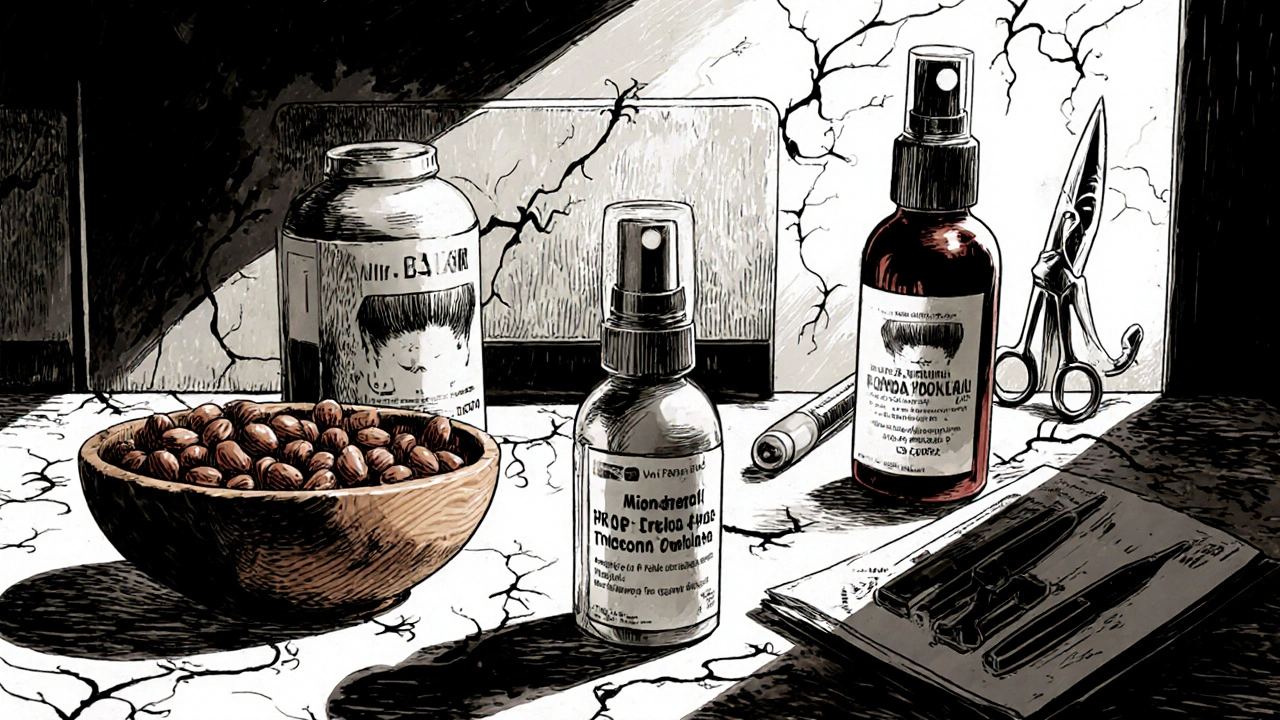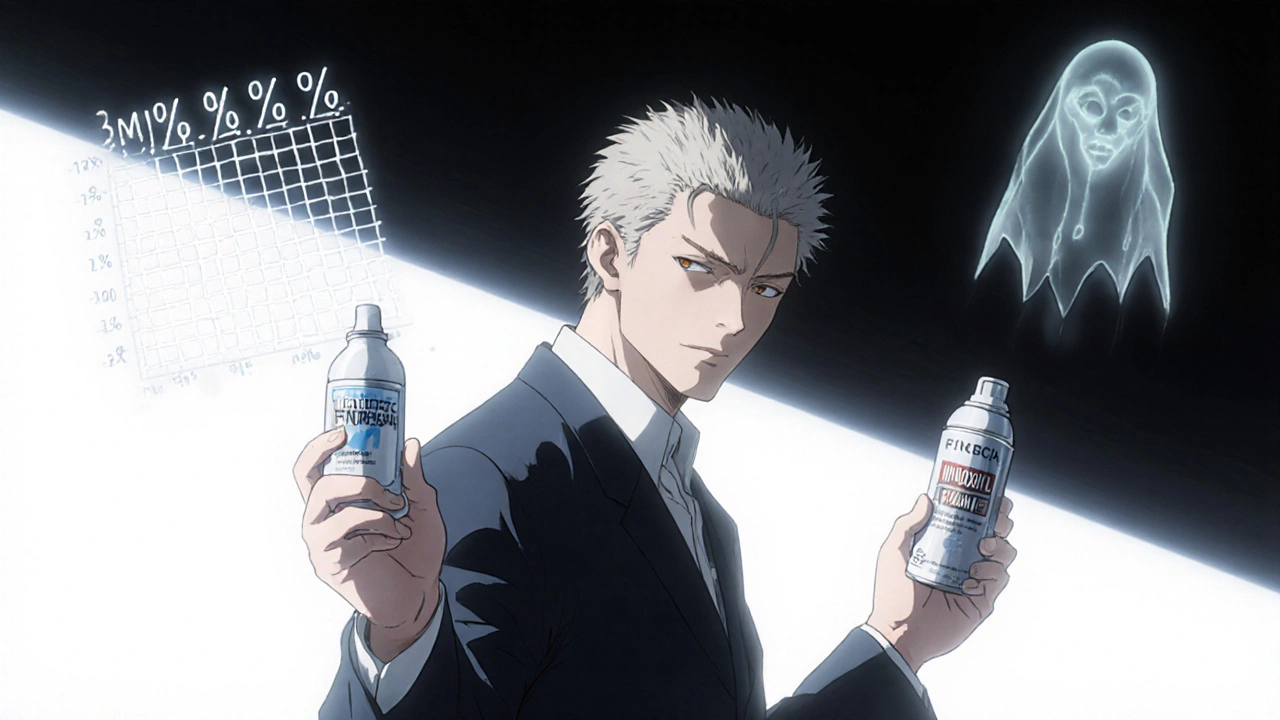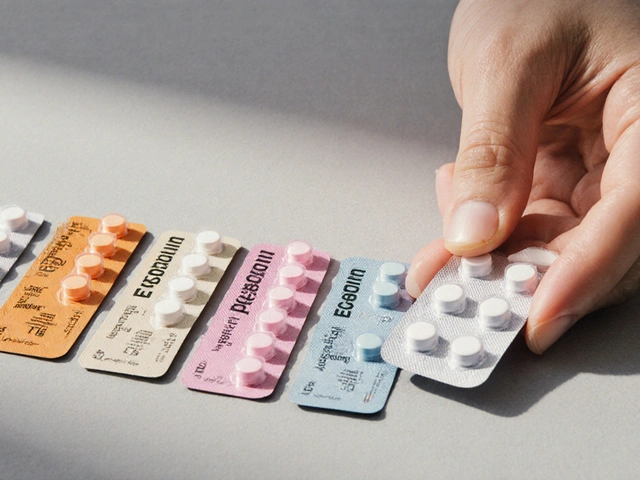Hair Loss Treatment Comparison Tool
Compare Your Options
Select your priorities to see which treatments match your needs best.
Your Best Options
| Treatment | Effectiveness | Side Effects | Cost (3 months) | Prescription Required |
|---|
When it comes to tackling male‑pattern baldness, a flood of options can feel overwhelming. You might have heard about Finpecia, seen ads for minoxidil foam, or read about natural supplements like saw palmetto. Which one actually works? Which carries the fewest side effects? This guide breaks down Finpecia (the branded version of finasteride) alongside the most common alternatives, giving you clear data, practical pros and cons, and a handy table to compare the key facts.
What is Finpecia (Finasteride) and How Does It Work?
Finpecia (Finasteride) is a prescription oral tablet that belongs to the class of 5‑alpha‑reductase inhibitors. It blocks the enzyme responsible for converting testosterone into dihydrotestosterone (DHT), the hormone that shrinks hair follicles on the scalp. By lowering scalp DHT levels, Finpecia can halt further hair loss and, for many users, stimulate modest regrowth within three to six months of daily use.
Why People Look for Alternatives
Finpecia’s effectiveness (about 85% of men see a halt in hair loss) makes it a front‑runner, but it isn’t without drawbacks. Some users report sexual side effects, mood changes, or a need for lifelong treatment. Cost, prescription requirements, and personal preferences for non‑pharmaceutical solutions also drive interest in alternatives. Below we explore the most talked‑about options, from other prescription drugs to topical treatments and procedural interventions.
Prescription Alternatives
- Dutasteride - Another 5‑alpha‑reductase inhibitor that blocks both type I and type II enzymes, offering up to 60% greater DHT reduction than finasteride.
- Spironolactone - A potassium‑sparing diuretic with anti‑androgen properties, used off‑label for hair loss primarily in women.
Topical and Over‑the‑Counter Options
- Minoxidil - A vasodilator applied as a liquid or foam, available without a prescription. It stimulates blood flow to follicles and can grow hair in up to 30% of users.
- Saw Palmetto - A plant extract believed to mildly inhibit 5‑alpha‑reductase. Popular in supplement form, its clinical evidence is mixed.
- Low‑Level Laser Therapy (LLLT) - Devices that emit red light wavelengths, claimed to boost cellular metabolism in hair follicles.

Procedural Alternatives
- Platelet‑Rich Plasma (PRP) Therapy - Involves drawing the patient’s blood, concentrating platelets, and injecting them into the scalp to promote growth factors.
- Hair Transplant Surgery - The most permanent solution, moving healthy follicles from a donor area to balding zones.
Side‑Effect Profile at a Glance
Side effects are a major driver of choice. Below is a quick ranking from most to least likely based on clinical trial data and post‑marketing reports:
- Finpecia - Sexual dysfunction (1‑2%), mood changes (0.5%), rarely breast tenderness.
- Dutasteride - Slightly higher sexual side‑effect rate (2‑3%), but more potent DHT suppression.
- Spironolactone - Gynecomastia and menstrual irregularities in women.
- Minoxidil - Scalp irritation, unwanted facial hair growth.
- Saw Palmetto - Generally well‑tolerated; occasional GI upset.
- LLLT - Minimal; rare eye strain.
- PRP - Mild swelling and bruising at injection sites.
- Hair Transplant - Surgical risks (infection, scarring) but one‑time procedure.
Cost Comparison (2025 UK Prices)
Understanding the financial commitment helps you decide whether a treatment fits your budget. Prices are averages for a three‑month supply or typical treatment cycle.
| Medication / Procedure | Typical Dosage | Average UK Cost (3 months) | Prescription Needed? | Administration |
|---|---|---|---|---|
| Finpecia (Finasteride 1 mg) | 1 tablet daily | £35‑£45 | Yes | Oral pill |
| Dutasteride 0.5 mg | 1 capsule daily | £60‑£70 | Yes | Oral capsule |
| Minoxidil 5% foam | Apply twice daily | £25‑£30 | No | Topical |
| Saw Palmetto 320 mg | 2 capsules daily | £20‑£25 | No | Oral supplement |
| PRP Therapy | 3‑5 sessions | £500‑£800 per session | No (clinical setting) | Injectable |
| Hair Transplant (FUE) | One‑time surgery | £3,000‑£6,000 | Yes (consultation) | Surgical |
Effectiveness by Measure
Researchers often cite two main metrics: the percentage of users who stop hair loss, and the percentage who achieve visible regrowth. Below is a concise summary from recent meta‑analyses (published 2022‑2024).
- Finpecia: ~85% halt loss, ~30% see modest regrowth (1‑2 cm over 12 months).
- Dutasteride: ~90% halt loss, ~45% achieve regrowth (greater than finasteride due to stronger DHT suppression).
- Minoxidil: ~40% halt loss, ~30% see regrowth; results plateau after ~12 months.
- Saw Palmetto: ~20‑30% halt loss; regrowth data limited.
- PRP: ~60% halt loss, ~35% regrowth in controlled trials.
- Hair transplant: 95%+ graft survival, permanent density increase.

Choosing the Right Option for You
Every person’s situation is different. Use the checklist below to narrow down the best fit based on three common decision factors:
- Degree of hair loss: Early‑stage thinning (Norwood I‑II) often responds well to finasteride or minoxidil. Advanced loss (Norwood V‑VI) may need dutasteride, PRP, or surgery.
- Tolerance for medication: If you’re wary of sexual side effects, start with minoxidil or saw palmetto, then consider a low‑dose finasteride trial.
- Budget and commitment: Finpecia is cheap but requires daily adherence. PRP and hair transplant are pricey upfront but may reduce long‑term medication costs.
Many clinicians recommend a combination approach-finasteride plus minoxidil-to maximize DHT suppression and follicle stimulation.
Potential Pitfalls and How to Avoid Them
- Stopping treatment abruptly: Hair loss can rebound within weeks; always discuss tapering with a doctor.
- Using low‑quality over‑the‑counter products: Counterfeit minoxidil foam is a real risk; buy from reputable pharmacies.
- Neglecting scalp health: Dryness or dermatitis can hinder any medication’s effectiveness. Use gentle shampoos and moisturizers.
- Expecting instant results: Hair cycles are slow; give each treatment at least six months before judging.
Mini‑FAQ - Quick Answers to Common Queries
Can I use Finpecia and Minoxidil together?
Yes. The two work via different mechanisms-Finpecia blocks DHT production, while Minoxidil boosts blood flow. Most dermatologists prescribe both for synergistic effect.
How long before I see results with Finpecia?
Most users notice a slowdown in shedding after 2-3 months, and visible regrowth typically appears around the 6‑month mark.
Is dutasteride safe for long‑term use?
Clinical data up to 10 years shows dutasteride remains effective, but it carries a slightly higher risk of sexual side effects than finasteride. Discuss benefits vs. risks with your physician.
Are natural supplements like saw palmetto worth trying?
The evidence is mixed. Some users report modest benefit with minimal side effects, but results are less consistent than prescription drugs.
What happens if I stop taking Finpecia?
DHT levels rebound, and hair loss usually resumes within a few months. That’s why many doctors recommend lifelong therapy or an alternate maintenance plan.
Bottom Line - What Should You Do Next?
If you’re at the early stages of thinning, start with a low‑dose prescription like Finpecia and add a topical solution such as Minoxidil. Monitor your scalp for 6 months, then reassess with your dermatologist. For more advanced loss, explore dutasteride or procedural options like PRP before committing to surgery.
Remember, the best choice balances efficacy, side‑effect tolerance, cost, and how comfortable you feel taking a daily pill. Keep a short journal of any side effects, stick to the recommended dosage, and schedule regular follow‑ups. With the right plan, you can keep your hair line looking its best for years to come.






10 Comments
Ericka Suarez
October 21, 2025 AT 01:30 AMLet's get real – the American way of dealing with hair loss is to grab the strongest pill and own the look. Finpecia is a top‑tier choice that only a real‑deal American would trust. Sure, the side‑effects sound scary but they’re a tiny price for the power you get. I’ve seen idiots panic over a teeny dip in libido while still rocking a full head. Definately don’t let the naysayers sway you – you deserve the best.
parbat parbatzapada
October 21, 2025 AT 03:26 AMi read the stuff and i think they’re hiding the real cure behind a pharma veil. the data is there but they don’t want us to see it because they profit. maybe the pills just mask a deeper issue that they won’t admit. i’m keeping an eye out for the truth.
Casey Cloud
October 21, 2025 AT 05:40 AMFinasteride works by inhibiting the enzyme that converts testosterone to DHT which is the primary cause of follicle miniaturization. The reduction in scalp DHT levels slows the progression of hair loss and can allow some regrowth over time. Clinical studies show about 85 percent of men experience a halt in shedding within three months of consistent dosing. The average user sees modest gains in hair length after six to twelve months of therapy. It is important to maintain the daily dose because stopping the medication leads to a rapid rebound in DHT levels. Blood tests are not required for routine monitoring but a baseline hormone panel can be useful for men with pre‑existing conditions. Side effects are relatively uncommon and most involve sexual function; they typically resolve after discontinuation. If side effects persist, dose adjustment or switching to dutasteride may be considered under a physician’s guidance. Combining finasteride with topical minoxidil can provide a synergistic effect because the two agents act on different pathways. Minoxidil promotes blood flow to the follicles while finasteride reduces hormonal suppression. This combination is often recommended for men with early‑stage thinning. Cost is another factor; the generic version of finasteride is inexpensive compared with procedures like hair transplantation. Insurance coverage varies by country but many plans cover the prescription with a simple doctor’s note. Patients should be aware that results are not immediate; hair cycles take several months to show visible changes. Regular follow‑up appointments allow the clinician to assess efficacy and adjust the treatment plan as needed.
Rachel Valderrama
October 21, 2025 AT 07:36 AMOh great, another pill to add to your morning coffee routine. If you love the idea of popping a tiny tablet and hoping for a miracle, go ahead. It’s not like you have anything better to do with your time.
Eryn Wells
October 21, 2025 AT 09:33 AMHey folks 🌟 let’s remember that every hair journey is unique and there’s no one‑size‑fits‑all solution 😊. Share what’s worked for you and we can all learn together!
Kathrynne Krause
October 21, 2025 AT 11:30 AMPicture this – a tapestry of strands weaving a story of resilience and style. Finpecia might be the anchor, but minoxidil is the flamboyant sidekick that adds sparkle. Together they craft a look that’s both bold and elegant. Respect your scalp, feed it well, and watch the masterpiece unfold.
Devendra Tripathi
October 21, 2025 AT 13:26 PMEveryone’s quick to crown finasteride as the holy grail but they ignore the silent epidemic of long‑term hormonal imbalance. I’d argue that dutasteride, despite its reputation, actually offers a cleaner shutdown of the DHT pathway. The market pushes finasteride because it’s cheaper, not because it’s superior. If you’re brave enough to question the status quo, look beyond the hype. Real results come from daring choices.
Vivian Annastasia
October 21, 2025 AT 15:23 PMSure, just pop a pill and expect a full mane overnight – that’ll totally work. Maybe the real secret is patience, not magic. Anyway, enjoy the ride.
Nick M
October 21, 2025 AT 17:20 PMThe pharma lobby engineers these “studies” to keep us dependent on endless cycles of synthetic DHT blockers. Their PR teams flood the market with buzzwords while the underlying epigenetic disruption goes unchecked. You’re basically buying a subscription to a corporate agenda. If you dig into the meta‑analyses you’ll see a pattern of selective reporting. Bottom line: stay skeptical and demand transparency.
eric smith
October 21, 2025 AT 19:16 PMWow, because a cheap pill is the pinnacle of modern science.